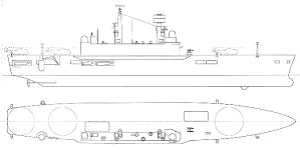- Joined
- 27 September 2006
- Messages
- 6,417
- Reaction score
- 6,815
In Friedman's book on British Destroyers and Frigates there is an interesting account of how the Royal Navy looked at the competing virtues of two ships which are described but never illustrated.
The first is a 10,000 ton escort cruiser armed with Seadart launchers front and aft and with a sponson mounted Ikara asw launcher (similar to that originally planned for CVA 01). The second is a 6,000 ton destroyer design derived from the Type 82 (Bristol) armed with a single Seadart launcher forw'd and a helicopter pad aft. Both were expected to carry Chinook size helos (later Seakings).
The RN preferred the Escort Cruiser and would have ordered them for delivery at the end of the 60s if Polaris costs and design staff shortages had not led to a postponement and the conversion of the Tiger class cruisers to helicopter carriers for replacement at the end of the 70s.
In 1966 the Escort Cruiser was still planned to join the fleet in the late 70s. The RN again looked at the Type 82 to provide a cheaper alternative. By 1967 the CVA 01 had been cancelled and the Escort Cruiser became a Command Cruiser (described publicly as an enlarged Type 82) and Type 82 was replaced with the smaller Type 42.
Given the fiasco of the Tiger conversions it is perhaps not surprising that the RN has still not published whatever drawings were done of the 1962 Seadart ships. The old fashioned looking Seaslug ships always shown and the later 1966 Working party ships are completely different designs. Maybe one day the drawings will surface.
UK 75
The first is a 10,000 ton escort cruiser armed with Seadart launchers front and aft and with a sponson mounted Ikara asw launcher (similar to that originally planned for CVA 01). The second is a 6,000 ton destroyer design derived from the Type 82 (Bristol) armed with a single Seadart launcher forw'd and a helicopter pad aft. Both were expected to carry Chinook size helos (later Seakings).
The RN preferred the Escort Cruiser and would have ordered them for delivery at the end of the 60s if Polaris costs and design staff shortages had not led to a postponement and the conversion of the Tiger class cruisers to helicopter carriers for replacement at the end of the 70s.
In 1966 the Escort Cruiser was still planned to join the fleet in the late 70s. The RN again looked at the Type 82 to provide a cheaper alternative. By 1967 the CVA 01 had been cancelled and the Escort Cruiser became a Command Cruiser (described publicly as an enlarged Type 82) and Type 82 was replaced with the smaller Type 42.
Given the fiasco of the Tiger conversions it is perhaps not surprising that the RN has still not published whatever drawings were done of the 1962 Seadart ships. The old fashioned looking Seaslug ships always shown and the later 1966 Working party ships are completely different designs. Maybe one day the drawings will surface.
UK 75


